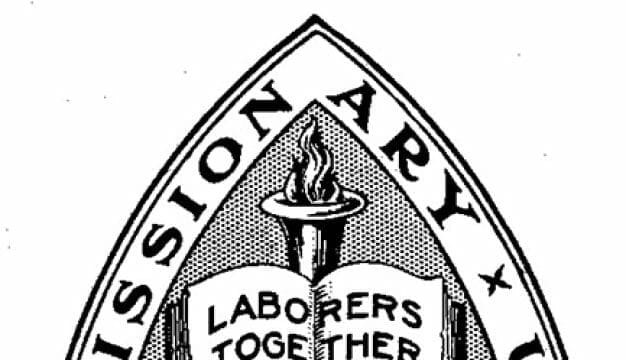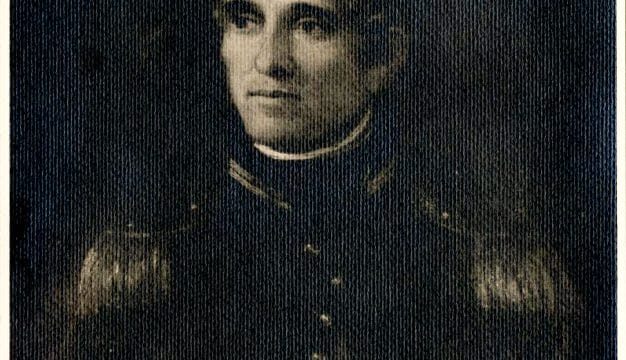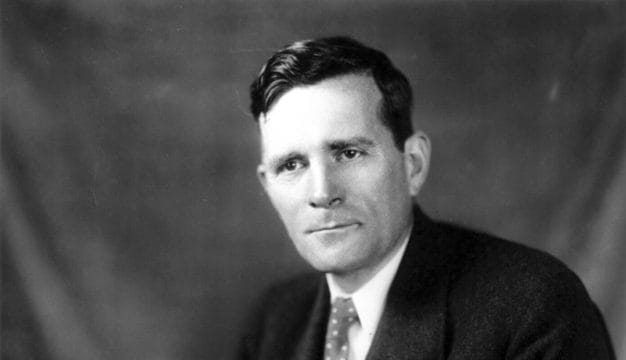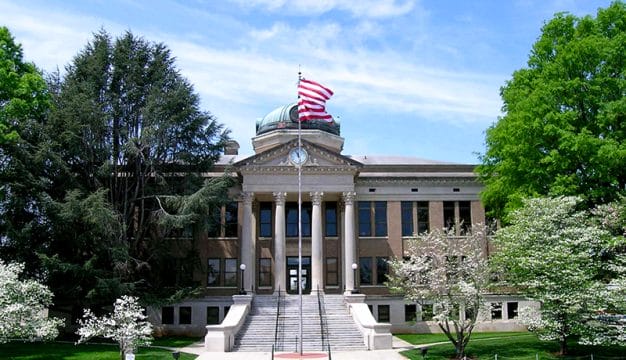Tuskegee Institute Movable School
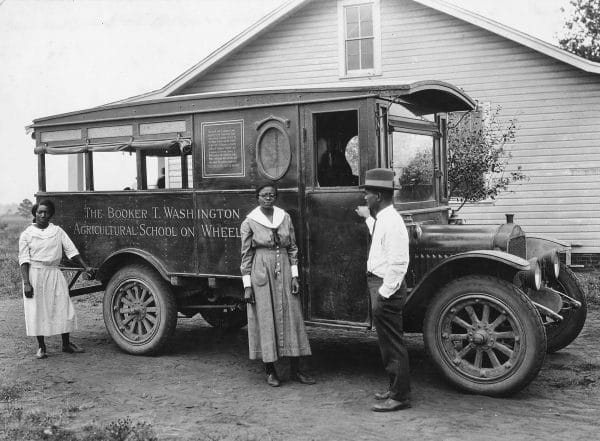 Tuskegee Institute Movable School
The Tuskegee Institute Movable School was an outreach effort of the Tuskegee Institute (now Tuskegee University) aimed at bringing modern agricultural tools and methods to rural areas and people in Alabama. First established by agricultural researcher and professor George Washington Carver, the Movable School was later managed by Carver protégé and Tuskegee graduate Thomas Monroe Campbell. The Movable School operated in several official incarnations, starting with the Jesup Agricultural Wagon in 1906 and ending with the Booker T. Washington Agricultural School on Wheels through 1944. Similar projects continue today in the form of traveling veterinary practices.
Tuskegee Institute Movable School
The Tuskegee Institute Movable School was an outreach effort of the Tuskegee Institute (now Tuskegee University) aimed at bringing modern agricultural tools and methods to rural areas and people in Alabama. First established by agricultural researcher and professor George Washington Carver, the Movable School was later managed by Carver protégé and Tuskegee graduate Thomas Monroe Campbell. The Movable School operated in several official incarnations, starting with the Jesup Agricultural Wagon in 1906 and ending with the Booker T. Washington Agricultural School on Wheels through 1944. Similar projects continue today in the form of traveling veterinary practices.
From its inception, Booker T. Washington envisioned Tuskegee Institute as having an outreach mission. Soon after he arrived in Macon County to establish the Tuskegee Normal and Industrial Institute in 1881, Washington began to make regular trips on horseback to talk, eat, and stay overnight with the rural people he hoped to educate at his school. It soon became evident to Washington, however, that those who needed education the most were the region’s farmers; he further realized that that education must be brought to those farmers, who were generally tied to their land and unable to travel for instruction.
 George Washington Carver
In 1896, George Washington Carver arrived at Tuskegee to head the school of agriculture. He carried Washington’s practice of rural visits further by loading a buggy with tools and materials and traveling to farms on weekends to give practical demonstrations. This activity was formalized when Washington gained political support in 1897 from the Alabama State Legislature to establish the Tuskegee Agricultural Experiment Station, which included a four-wheeled coach, or “carry-all,” loaded with tools, seed packets sent by U.S. Secretary of Agriculture James Wilson, and some boxed demonstration plants, to help educate farmers. Despite more formal methods to reach the rural population at Tuskegee Institute, including the Annual Negro Conference (1892), the Monthly Farmers’ Institute (1898), and the Farmers’ Short Courses in Agriculture (1904), Booker T. Washington never forgot those who could not afford to or were unable to travel to such programs. Accordingly, Washington instructed a committee led by George Washington Carver to design a wagon that would carry equipment and perform demonstrations in the fields of the farmers.
George Washington Carver
In 1896, George Washington Carver arrived at Tuskegee to head the school of agriculture. He carried Washington’s practice of rural visits further by loading a buggy with tools and materials and traveling to farms on weekends to give practical demonstrations. This activity was formalized when Washington gained political support in 1897 from the Alabama State Legislature to establish the Tuskegee Agricultural Experiment Station, which included a four-wheeled coach, or “carry-all,” loaded with tools, seed packets sent by U.S. Secretary of Agriculture James Wilson, and some boxed demonstration plants, to help educate farmers. Despite more formal methods to reach the rural population at Tuskegee Institute, including the Annual Negro Conference (1892), the Monthly Farmers’ Institute (1898), and the Farmers’ Short Courses in Agriculture (1904), Booker T. Washington never forgot those who could not afford to or were unable to travel to such programs. Accordingly, Washington instructed a committee led by George Washington Carver to design a wagon that would carry equipment and perform demonstrations in the fields of the farmers.
The Jesup Agricultural Wagon
 Jesup Agricultural Wagon
Washington took Carver’s plans to Morris K. Jesup, a benefactor of the school from New York City, who supplied financial support for constructing a wagon and purchasing mules, materials for harnesses, and demonstration materials. The total cost was $674.50, with the wagon and harness constructed on the Tuskegee campus by the students. The newly named Jesup Agricultural Wagon left the Tuskegee campus on May 24, 1906, under the direction of George Bridgeforth of the Agricultural Department. In November 1906, supervision of the Movable School was taken over by Thomas Monroe “T. M.” Campbell.
Jesup Agricultural Wagon
Washington took Carver’s plans to Morris K. Jesup, a benefactor of the school from New York City, who supplied financial support for constructing a wagon and purchasing mules, materials for harnesses, and demonstration materials. The total cost was $674.50, with the wagon and harness constructed on the Tuskegee campus by the students. The newly named Jesup Agricultural Wagon left the Tuskegee campus on May 24, 1906, under the direction of George Bridgeforth of the Agricultural Department. In November 1906, supervision of the Movable School was taken over by Thomas Monroe “T. M.” Campbell.
Fully equipped, the Jesup Wagon, as it was commonly called, carried a revolving churn, butter mold, diverse cultivator, planters, a cotton chopper, plows, different kinds of fertilizers, seeds, food stuffs, a milk tester, and a cream separator, as well as a number of charts and demonstration materials. Recommended breeds of cows and chickens, well-developed ears of corn, stalks of cotton, bundles of oats and seeds, and garden products were included, all based on the locality visited and the season of the year.
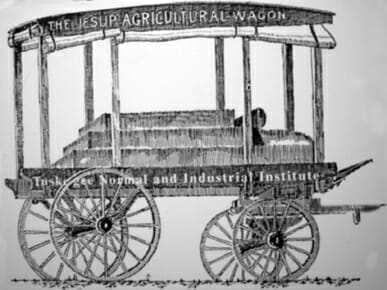 Carver Drawing of the Jesup Wagon
Termed by Booker T. Washington as a “Farmers’ College on Wheels,” the Jesup Wagon would first visit a farmer’s field to demonstrate modern plowing practices or innovations in animal husbandry or plant varieties, fertilizer applications, and soil testing. Instruction in raising poultry, cooking, preserving and canning, home maintenance, and health then would be offered to the women of the household. After visiting area farms, the wagon would then proceed to a central community location for questions and answers from men and women, young and old. Local sentiment for the Jesup Wagon was enthusiastic, and over the first summer of operation its programs reached an average of 2,000 people per month. White plantation owners also requested visits from the Jesup Wagon for instruction for their tenants in improved farming methods.
Carver Drawing of the Jesup Wagon
Termed by Booker T. Washington as a “Farmers’ College on Wheels,” the Jesup Wagon would first visit a farmer’s field to demonstrate modern plowing practices or innovations in animal husbandry or plant varieties, fertilizer applications, and soil testing. Instruction in raising poultry, cooking, preserving and canning, home maintenance, and health then would be offered to the women of the household. After visiting area farms, the wagon would then proceed to a central community location for questions and answers from men and women, young and old. Local sentiment for the Jesup Wagon was enthusiastic, and over the first summer of operation its programs reached an average of 2,000 people per month. White plantation owners also requested visits from the Jesup Wagon for instruction for their tenants in improved farming methods.
As time passed and farm demonstrations become more specialized, the Jesup Wagon agent would discuss the current topic of the season, for example, general farming, dairying, or truck farming. With the passage of the Smith-Lever Act creating a national extension system in 1914, increased financial support allowed for a woman home demonstration agent to join the wagon staff. During all visits, instructors distributed pamphlets on farm production, nutrition, and health from Tuskegee Institute.
Eventually, increased demand for the Jesup Wagon across the state expanded beyond its practical use. With no financial support to purchase a newer vehicle, demonstration agents travelled by train to small towns. This system presented further challenges, however, because the demonstration agent could not hire local transportation from the train station to a central meeting location; local farm visits thus became untenable.
The Knapp Agricultural Truck
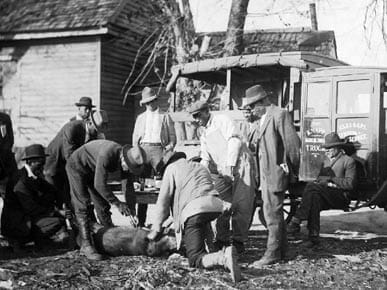 Knapp Agricultural Truck
In 1918, T. M. Campbell requested support from Alabama State Extension Director John Frederick Duggar to purchase a modern vehicle to replace the Jesup Wagon. He was given the needed funds and purchased a Ford truck that he named the Knapp Agricultural Truck in honor of Seaman A. Knapp, “father” of the national Cooperative Extension System. This new Movable School was met with enthusiasm, and in 1920 a registered nurse and Tuskegee graduate, Uva Mae Hester, was added to the staff to teach improved home health and sanitation.
Knapp Agricultural Truck
In 1918, T. M. Campbell requested support from Alabama State Extension Director John Frederick Duggar to purchase a modern vehicle to replace the Jesup Wagon. He was given the needed funds and purchased a Ford truck that he named the Knapp Agricultural Truck in honor of Seaman A. Knapp, “father” of the national Cooperative Extension System. This new Movable School was met with enthusiasm, and in 1920 a registered nurse and Tuskegee graduate, Uva Mae Hester, was added to the staff to teach improved home health and sanitation.
The Booker T. Washington Agricultural School on Wheels
 School on Wheels
After five years, the Knapp Agricultural Truck, as with the Jesup Wagon, was taxed beyond its means. In 1923, more than 30,000 enthusiastic supporters, many of them the African American farmers who had been helped by the Movable School, contributed $5,000 to purchase a new vehicle. Built in Montgomery by the Hobby Motor Company, the Booker T. Washington Agricultural School on Wheels truck was presented at the Thirty-second Annual Tuskegee Negro Conference in February.
School on Wheels
After five years, the Knapp Agricultural Truck, as with the Jesup Wagon, was taxed beyond its means. In 1923, more than 30,000 enthusiastic supporters, many of them the African American farmers who had been helped by the Movable School, contributed $5,000 to purchase a new vehicle. Built in Montgomery by the Hobby Motor Company, the Booker T. Washington Agricultural School on Wheels truck was presented at the Thirty-second Annual Tuskegee Negro Conference in February.
This third Movable School brought with it spraying equipment, a set of carpenter’s tools, a milk tester, an inoculating set for vaccinating livestock, a lighting plant for generating electricity on the farm, a moving picture projector, cameras, a sewing machine, an electric iron, a baby’s bath tub, a set of baby’s clothes, a medicine cabinet, kitchen utensils, and playground apparatus for recreational games. The staff of the Movable School continued to include a farm demonstration agent, a home agent and a registered nurse. This vehicle and its successors operated for another 20 years and was a welcomed visitor in rural communities.
The Movable School, in all its various incarnations, was a commitment by Booker T. Washington to carry the educational efforts of his school at Tuskegee to the farm families of rural Alabama.
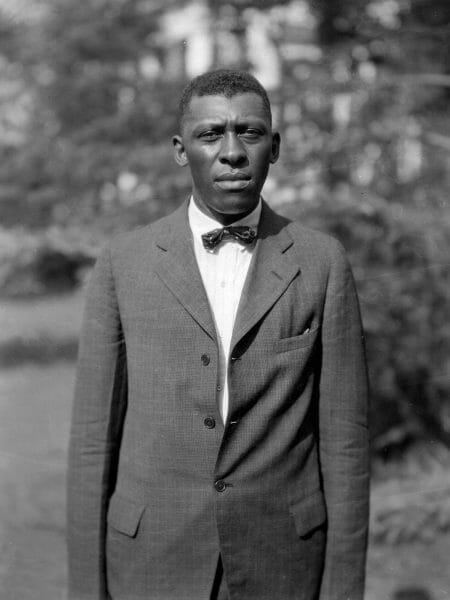 Thomas Monroe Campbell
It served this purpose admirably until a permanent workforce of Cooperative Extension Agents (Thomas Monroe Campbell was the very first federal extension agent, commissioned November 12, 1906, at Tuskegee Institute) was established in each county to provide the information once available only from the Movable School. In 1944 the Movable School was retired from service. A Booker T. Washington Agricultural School on Wheels is displayed at the George Washington Carver Museum on the Tuskegee University campus. Additionally, that institution’s School of Veterinary Medicine continues the Movable School tradition with its Large and Small Animal Ambulatory Trucks that bring the expertise of the school’s veterinary staff to the farmers and rural residents of the Black Belt.
Thomas Monroe Campbell
It served this purpose admirably until a permanent workforce of Cooperative Extension Agents (Thomas Monroe Campbell was the very first federal extension agent, commissioned November 12, 1906, at Tuskegee Institute) was established in each county to provide the information once available only from the Movable School. In 1944 the Movable School was retired from service. A Booker T. Washington Agricultural School on Wheels is displayed at the George Washington Carver Museum on the Tuskegee University campus. Additionally, that institution’s School of Veterinary Medicine continues the Movable School tradition with its Large and Small Animal Ambulatory Trucks that bring the expertise of the school’s veterinary staff to the farmers and rural residents of the Black Belt.
Additional Resources
Campbell, Thomas M. The Movable School Goes to the Negro Farmer. Tuskegee, Ala.: Tuskegee Institute Press, 1936.
James, Felix. “The Tuskegee Institute Movable School, 1906–1923.” Agricultural History 45 (July 1971): 201-9.
Jones, Allen W. “The Role of Tuskegee Institute in the Education of Black Farmers.” Journal of Negro History 60 (April 1975): 252-67.
Mayberry, B. D. The Role of Tuskegee University in the Growth and Development of the Negro Cooperative Extension System, 1881-1990. Tuskegee, Ala.: Tuskegee University Cooperative Extension Program, 1989.
